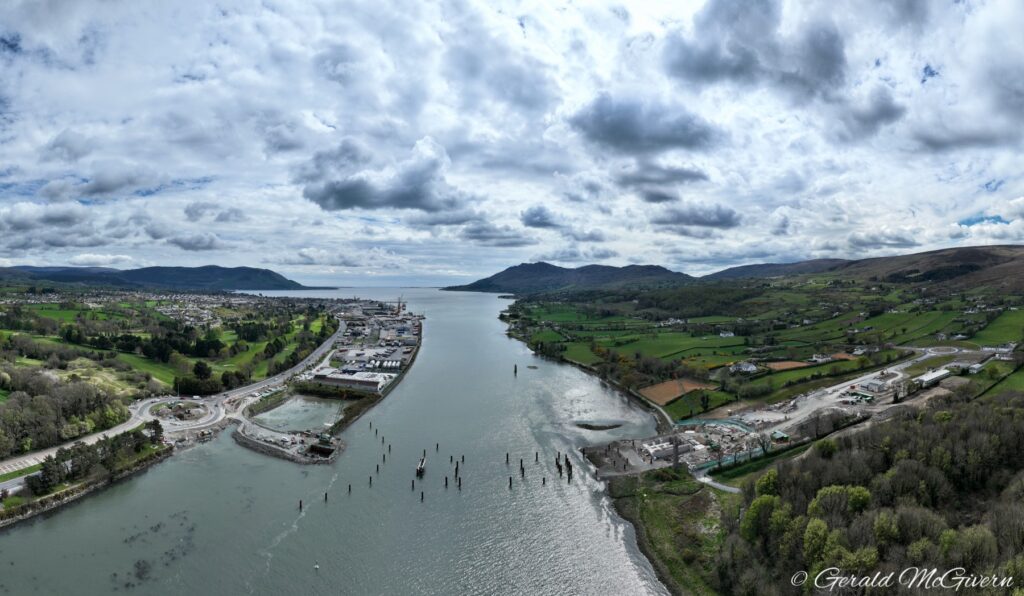- BY Kevin Barry BSc(Hons) MRICS
- POSTED IN Latest News
- WITH 0 COMMENTS
- PERMALINK
- STANDARD POST TYPE

As Strangford Lough Crossing (SLC) at early stages, we can review the processes and progress of Narrow Water Bridge, through the prism of Narrow Water Bridge Community Network, led by Chairman Jim Boylan, who, amongst others, campaigned for year to see this scheme develop. Thus far, the information shared and stories told, are interesting to say the least. Whilst we take baby steps at SLC, aiming to open discussions with the Irish Government to explore potential of SLC, let’s reflect on our neighbouring county progress thus far, and keep hoping, which is free, at least !
The Narrow Water Bridge project, a 195-meter cable-stayed bridge connecting Omeath in County Louth, Republic of Ireland, with Narrow Water near Warrenpoint, County Down, Northern Ireland, is a significant infrastructure initiative expected to deliver substantial economic and social benefits to the cross-border region. Construction began in June 2024 and is projected to be completed by late 2027 or early 2028.
Below is an overview of the indicative economic and social benefits based on available information up to July 31, 2025:
Economic Benefits
1. Boost to Tourism: – The bridge is anticipated to drive significant tourism growth in the Carlingford Lough region by connecting the Mourne Mountains and the Cooley Peninsula, enhancing access to greenways, mountain bike trails, walking routes, and beaches. Local businesses, such as galleries and pubs in Warrenpoint and Rostrevor, expect increased visitor footfall, with projections of hundreds of thousands of visitors annually. The project has already spurred investment in the area, with signs of revitalization in Warrenpoint, including upgrades to the town’s promenade and development of previously vacant sites like Cole’s Corner.
There is also renewed interest in redeveloping long-closed properties, such as the Park Hotel near the bridge site. The bridge’s ability to facilitate day trips around Carlingford Lough, encompassing Warrenpoint, Rostrevor, and Carlingford, is expected to attract small businesses like galleries, boutiques, and shops, further stimulating local economies.
2. Employment Opportunities: The construction phase, led by BAM Ireland and supported by contractors like Quinn Piling, is creating direct jobs for construction workers, engineers, and designers. Indirect employment is also generated through supply chains and local services supporting the project. Long-term, the bridge is expected to increase employment levels by fostering tourism and business growth, particularly in hospitality and retail sectors.
3. Economic Multiplier Effect: Wages paid to construction workers are reinvested into local businesses, creating a multiplier effect estimated to generate €1.50 in economic benefit for every €1 spent on worker salaries. This stimulates local economies in both Northern Ireland and the Republic of Ireland. The bridge’s role in connecting economically complementary areas—such as those with tourism assets and those with labor or business opportunities—enhances cash flow and economic activity across the border.
4. Infrastructure Investment: The €102 million project, funded by the Shared Island Fund, represents a significant investment in cross-border infrastructure. This funding supports not only the bridge construction but also related improvements, such as road upgrades and a new roundabout on the R173 Omeath Road, enhancing regional connectivity. The project’s visibility has attracted interest from investors, as evidenced by increased inquiries about properties like the Park Hotel, which had been dormant for nearly 20 years but is now seen as viable due to the bridge’s development.
Social Benefits
1. Enhanced Connectivity: The bridge will connect communities on both sides of Carlingford Lough, fostering stronger social ties between Northern Ireland and the Republic of Ireland. It will provide a direct link for vehicular, cycle, and pedestrian traffic, making cross-border travel easier and encouraging interaction. Integration with the Carlingford Lough Greenway and other active travel networks supports healthier lifestyles by promoting cycling and walking, enhancing community well-being.
2. Symbolic Unity: Described as a “symbol of connection, opportunity, and a shared vision,” the bridge embodies cross-border collaboration and reconciliation. It is seen as a physical manifestation of the Shared Island initiative’s goals, strengthening ties between communities north and south. Local leaders, including Louth County Council and the Department for Infrastructure, emphasize the bridge’s role in building lasting community relationships and fostering a sense of shared purpose.
3. Improved Access to Amenities: – The bridge will improve access to the region’s natural and cultural attractions, such as the Mourne Mountains and Cooley Peninsula, enhancing quality of life for residents and visitors alike. This improved access is expected to encourage recreational activities and cultural exchange. The bridge’s design, accommodating pedestrians and cyclists, ensures inclusivity, allowing diverse groups to benefit from enhanced mobility and access to regional amenities.
Challenges and Considerations
1. Environmental Concerns: Some local residents have raised concerns about the bridge’s environmental impact and the capacity of local infrastructure (e.g., roads and parking in Rostrevor) to handle increased tourism. These concerns highlight the need for careful planning to balance development with environmental and community preservation.
2. Construction Disruptions: While the project employs sustainable practices and modular construction to minimize disruptions, temporary impacts on local traffic and the environment are inevitable during the construction phase, expected to last until late 2027.
Conclusion
As of July 31, 2025, the Narrow Water Bridge project is already demonstrating economic benefits through increased investment, job creation, and tourism potential, with early signs of revitalization in Warrenpoint and surrounding areas. Socially, it promises to strengthen cross-border community ties, improve access to recreational and cultural assets, and serve as a symbol of unity. While challenges like environmental impacts and infrastructure capacity remain, the project’s alignment with sustainable practices and cross-border collaboration positions it as a transformative initiative for the Carlingford Lough region.
